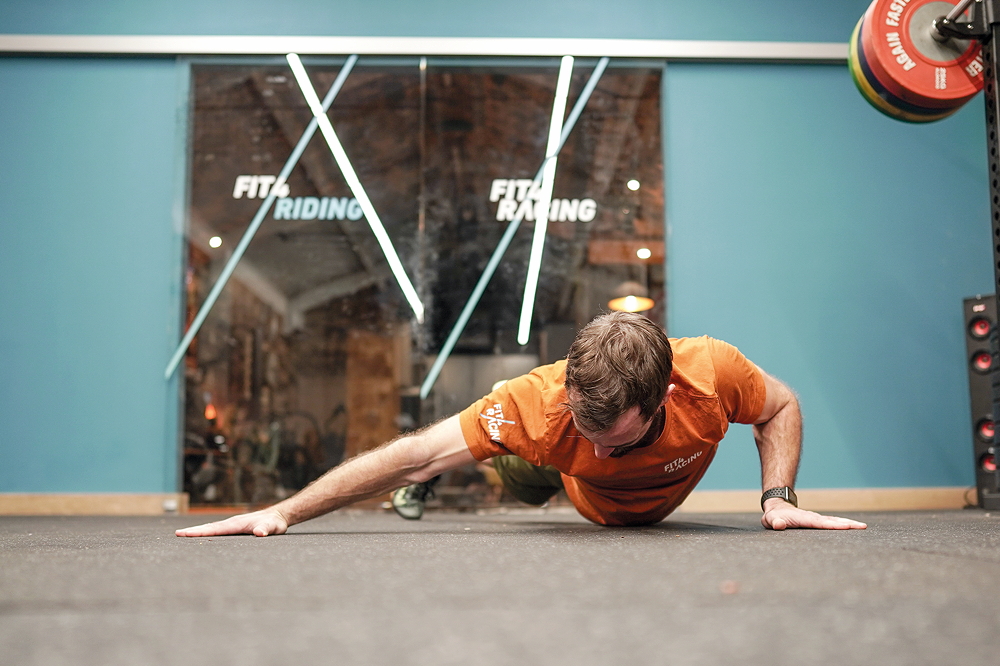Riding isn’t just about moving front to back, like most exercises in the gym – think squats and deadlifts. And while squats and deadlifts should form the basis of your strength development off the bike, we also need to move in ways that better represent the shapes we actually pull on the bike.
Sticking to movements in the sagittal plane (front to back) can lead to imbalances and also inhibit on-bike improvement. That is why we must include the other major planes of motion – frontal (side to side) and transverse (rotational) – in our mountain bike training. Imagine the positions and stresses you are under when riding, very few of those involve only one plane of motion. By training all planes, you will build true three-dimensional ability and improve overall function to help you ride better.
Read more: Let your bike know who’s the boss with the help of our tailor-made fitness sessions
Let’s take a look at four multi-dimensional movements that provide great crossover for riding. You can add these to your training easily and without any equipment.

1. Archer push-up
This push-up variation puts emphasis on loading one side more than the other. Get into the regular push-up position then extend one arm at 90 degrees to your torso. This is a great movement as it helps develop both rotational strength and mobility, while providing the opportunity to identify any side-to-side imbalance.
How to train the archer push-up
You will get the most benefit from archer push-ups by moving from one side to the other in a slow, controlled movement. Don’t be tempted to add speed until you are confident in the movement. Complete three to five sets of as many reps as possible, starting on your weak side first. Rest one to two minutes between sets.
BEGINNERS: Four to six reps on knees.
INTERMEDIATE: Four to six reps on toes.
ADVANCED: 12+ reps on toes.

Cossack squat 1

Cossack squat 2
2. The cossack squat
This is one of our favourite movements for increasing hip and ankle mobility. The key when performing cossack squats is to drop your bum back as you lower it, while pulling your chest up high. Once comfortable, you can increase the range of motion by pushing your knee as far forward as possible, making sure it is pointing the same direction as your toes. Adding a little weight in your hands is fine, but isn’t necessary unless you are training at a high level or don’t have access to heavier, weighted movements.
How to train the cossack squat
Regardless of ability level, you should be able to perform the cossack squats as described. The depth
and quality of position is key to improvement, not the total number of reps per set.
Alternate between sides for 10-12 reps slow and controlled, or try a 20-30 second hold in the bottom position each side.

Curtsy squat 1

Curtsy squat 2
3. Curtsy squat
This movement will help you corner like a boss. Much like the front-foot position of the cossack squat but the reaching leg extends behind and across you as far as you can manage.
How to train the curtsy squat
The curtsy squat adds a lot of rotation through your pelvis, lower abdomen and knee, so start gently, and only increase the range of motion as you begin to feel more comfortable.
BEGINNERS: Three rounds of 12, alternating with 60-90 seconds rest between rounds.
INTERMEDIATE: Three to five rounds of six-10 reps left side, rest for 60 seconds, six-10 reps right side. Rest for 60-90 seconds between rounds.
ADVANCED: Five rounds of 10-12 reps left side, rest for 60 seconds, repeat on right side, rest 60 for seconds.

Plank pull-throughs 1

Plank pull-throughs 2
4. Plank pull-throughs
The ability to maintain stability throughout your core while your limbs move freely will give you maximum control on the bike, and plank pull-throughs tick this anti- rotation box perfectly. Get on the floor in a push-up plank position then drag a weight underneath your torso; repeat in the opposite direction. Although a weight is needed to advance the exercise, a rucksack with some books will suffice.
How to train plank pull-throughs
Complete three sets for time, 30 seconds to start then build to one minute. Rest one to two minutes between sets.
BEGINNER: Start with a cloth or mat that slides easily on the floor to get used to the movement.
INTERMEDIATE: While maintaining good form, progress the exercise by gradually increasing the weight moved.
ADVANCED: Lift the opposite leg to the hand doing the dragging for the ultimate core workout.
Your coach
 Jonny Thompson is head coach for Fit4Racing, an online fitness programme for mtb riders. Once a forensic scientist, Jonny has devoted the last 10 years to coaching athletes, from Paralympians to world number one enduro racers. His main focus with the Fit4Racing team is developing and delivering fitness programmes to pro and amateur riders.
Jonny Thompson is head coach for Fit4Racing, an online fitness programme for mtb riders. Once a forensic scientist, Jonny has devoted the last 10 years to coaching athletes, from Paralympians to world number one enduro racers. His main focus with the Fit4Racing team is developing and delivering fitness programmes to pro and amateur riders.
Training the likes of Adam Brayton, Jonny also sends digital programmes to riders all over the world, many of whom ride professionally.



